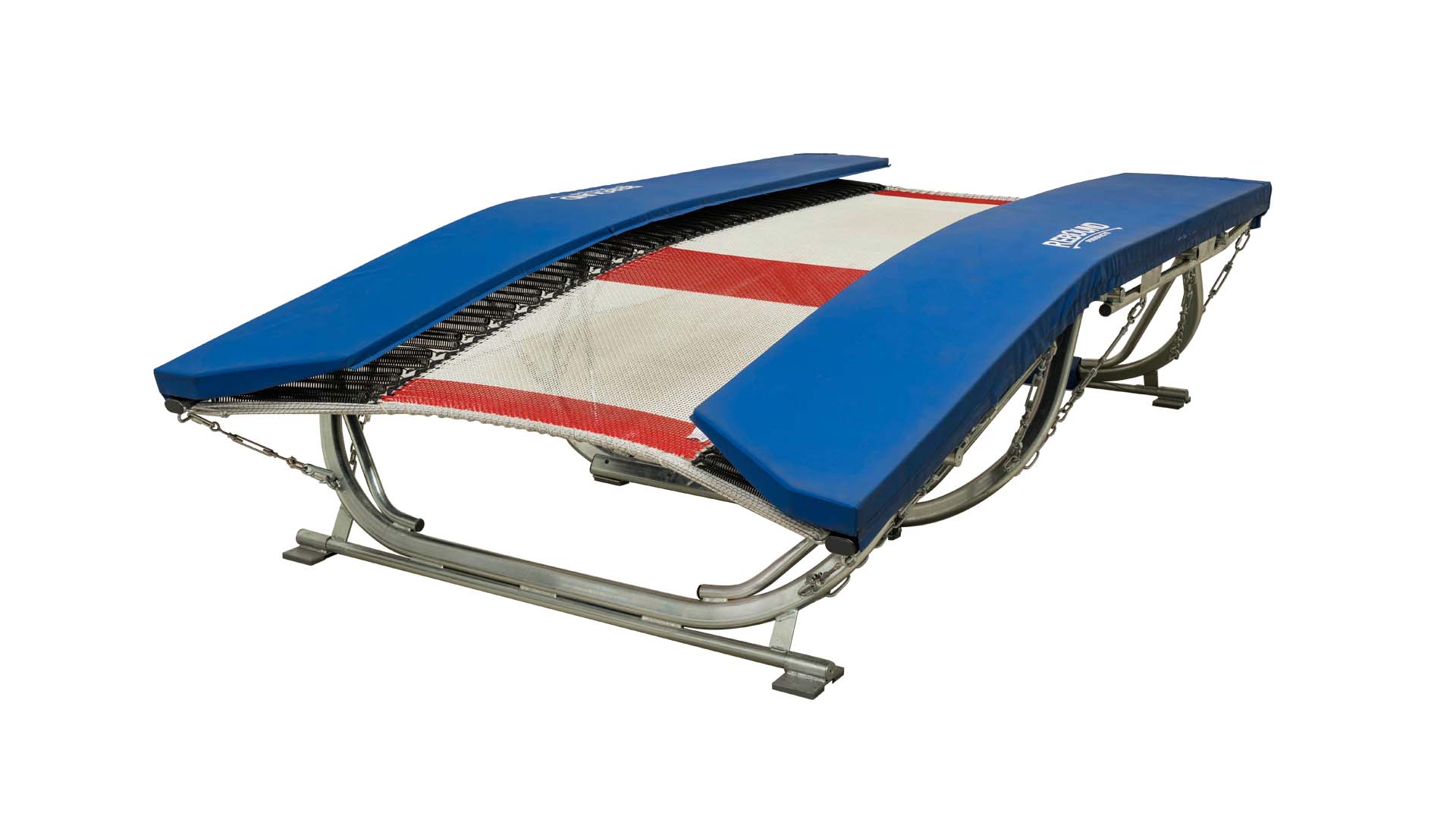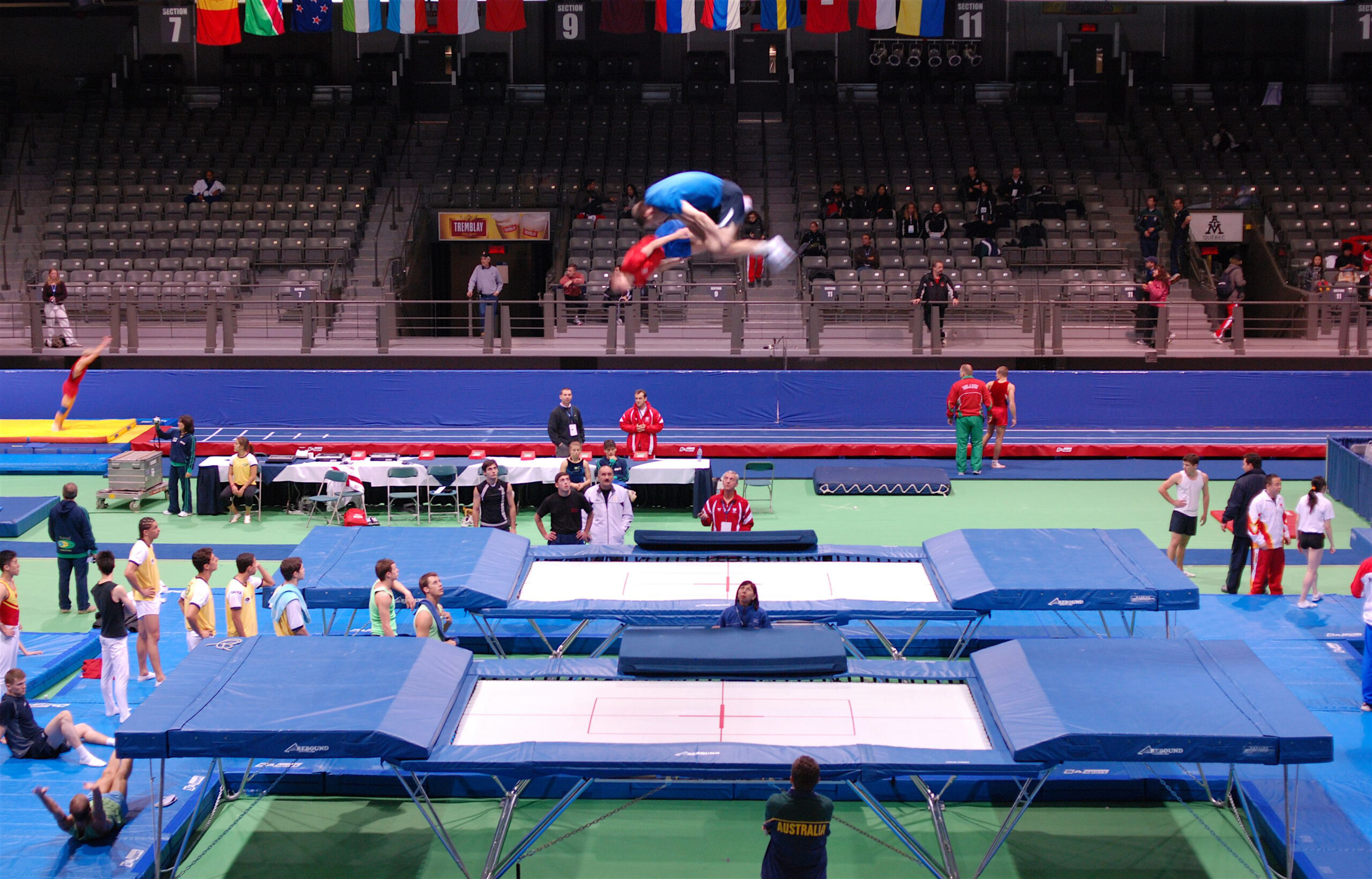Learn how to check for all kinds of problems
Check For Structural Problems
Look for defects which would make the trampoline unsafe to bounce on. These could be missing leg braces, quick links, chains, floor protectors and cracked welds. The area of highest stress on a folding trampoline frame is where the sleeve which allows the legs to turn, meets the midsections of the frame. Check for cracked welds, and re-weld if need be.
The next area of concern depending on the model you have is at the bottom of the legs where stress from the inner leg bars is transferred to the outer (main) leg bars. For example on a Nissen trampoline the outer leg bars will bend at the point where stress is concentrated.
On a Eurotramp frame which has had many years use, the oval outer tube will have cracks in it about ¼ inches away from the welds to the flat bars which transfer this stress. If you have a non-folding frame, check the joins for cracks and looseness Make sure the frame is within a ¼ inch of the same width at both hinges to see if leg repair work is needed to get an even bounce. Also look along the frame sides for straightness.
If the trampoline is a bit wider than the middle without springs this is normal. If it still looks a bit like that after the bed and springs are installed that also should not be a problem.
However if one end of the frame angles away from straight it will not be easy to get an even bounce. All quick links and/or chain attachments should be tightened so chain length is not changing from day to day. (A finger tight quick link can open with vibration and then bend or break!) All leg braces should be tightened to make sure that corner heights are fixed. Also check the spring attachment points for wear. If they are hardly or partly worn, a set of frame clips would be a good wear prevention method.
If the attachment points are almost worn through, then they should be re-welded before the trampoline is used. If the floor protectors are extremely worn or broken, they should be replaced. When set up a frame should provide a solid and level platform for your bed and springs.

This means the frame should not slide on the floor or move significantly when in use. MAKE THE TRAMPOLINE LEVEL Making a frame level, is much easier if the floor it is placed on is level, as now only measurements from the spring attachments to the floor need be taken. The first step is to adjust the four hinge points on the middle section of the trampoline to be at the same height. (Competition trampolines now have the bed 45 &5/8 inches or 116cm from the floor.) This adjustment is made by varying chain length. Once you think you have the correct position make sure that the chains are all tight by pulling out one of the trampoline legs. If the chains have turnbuckles, make sure that both lock nuts on each of them are tight, once adjustments are finished. If the chain adjustment is made by a set screw in a collar which slides, then a small dent in the frame made with a drill bit, can reduce the possibility of the set screw sliding once the correct position is known.
Whatever the method of chain length adjustment, ensure that this is fixed once properly set. The second step is to adjust the four corners to be level with the middle section.
This is done on a folding trampoline frame by adjusting the length of the leg braces. Once all four are adjusted so the ends and sides are level, ensure that any set screws are tight enough to stay put if an athlete impacts the frame. If an athlete has impacted the end frame or end decks, often one leg of the trampoline needs to be pulled out to re-tighten the chains. Check that the springs pull evenly.
Try to have the same type of springs everywhere on the trampoline except in the corners where special larger springs are often placed. If this is not possible try to match the spring types you have so that equal spring types are opposite each other. This can be achieved by using one type of spring on the ends and another on the sides, or alternating spring types etc.
Beware that if you have a particularly low tension spring type that these should be interspersed with the better springs if you have must use them. Putting them all in one area will create a soft spot.
It might seem less important to have tight corners as you usually don’t land in the corners, but a soft corner could cause an athlete to fall off! The ideal solution is to get enough new springs to bring you trampolines tension up to what it should be. This is about 38 pounds of tension at the length a spring has without anyone on the trampoline. (Corner springs should start out above 45 pounds tension and are also stiffer bouncing than regular springs so they must only be places near the corners.) A relatively compact and low priced scale useful for measuring spring tension can be found wherever supplies for fishing are sold.
Look down the bed lengthwise and widthwise to see if the centerline is straight. This is a good visual way to check for concentrations of soft springs. If there are no replacement springs put the soft ones opposite each other and well separated from each other.

Replace or repair worn parts Wear in a bed can usually be seen. However it should not be ignored. All types of beds will eventually wear out. If the stitching or webbing needs to be replaced on a webbed bed, replace it. If a string is broken on a string bed, tie a new one in so the knots are on the bottom of the bed. Usually if a black bed has a rip in it, the entire bed should be replaced. The exception might be a cigarette hold burn in an area of low wear.
However a patch of new bed material should be sewn over the hole and the sewing will create a new weakness. Springs can over-stretch and loose their tension, or they can break. If the break is in the middle of the spring likely that spring has given you the maximum possible lifetime of many thousand cycles. If the spring tension is not sufficient the lowest tension springs should be replaced. Always have a few spare springs around even some older ones, as if an athlete actually lands on only one spring it clearly will no longer be useable.

